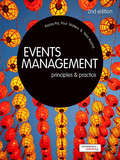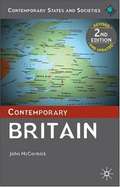- Table View
- List View
Saturn V Rocket (UEB Uncontracted)
This is an image of the Saturn V rocket: the type that carried American astronauts on the various Apollo missions to the moon in the 1960s and '70s. There is a locator dot shown, which will be at the top left of the page when the image is the right way up. The rocket is seen from the side moving diagonally from the bottom left of the page to the top right. It was 354 feet (108 metres) high and consisted of four stages, the last of which landed on the moon. At the bottom left of the page are the first stage rocket engine's exhaust gases pushing the vehicle through the atmosphere. Up and right from this are three of the five first stage engine outlets. Moving up and to the right are the rest of the rocket stages; they are marked by lines across the width of the launch vehicle. The fine textured section at the top right of the page is the spacecraft. This carried the astronauts and the lunar module, which travelled to and landed on the moon. The pointed section at the very top was the LES (launch escape system)
SpaceShipOne (UEB Uncontracted)
This page shows an image of SpaceShipOne, designed to be the first non-government funded craft to reach the edge of space at just over one hundred kilometres. It was launched from a purpose-built aircraft, White Knight. There is a locator dot shown, which will be at the top left of the page when the image is the right way up. At the top centre of the page is the nose cone of the craft with many small round windows shown in a heavy texture. Down the page is the body of the plane and down again is the nozzle of the engine and the hot gases being expelled towards the bottom of the page. To the left and right of the body are the two wings. They are hinged so that their configuration can be changed for the climbing, gliding, and re-entry stages of flight.
SpaceShipOne (Large Print)
This page shows an image of SpaceShipOne, designed to be the first non-government funded craft to reach the edge of space at just over one hundred kilometres. It was launched from a purpose-built aircraft, White Knight. There is a locator dot shown, which will be at the top left of the page when the image is the right way up. At the top centre of the page is the nose cone of the craft with many small round windows shown in a heavy texture. Down the page is the body of the plane and down again is the nozzle of the engine and the hot gases being expelled towards the bottom of the page. To the left and right of the body are the two wings. They are hinged so that their configuration can be changed for the climbing, gliding, and re-entry stages of flight.
Space Shuttle (UEB Uncontracted)
This is a diagram of an American space shuttle, designed to carry large loads in an orbital path around the circumference of the Earth. There is a locator dot shown, which will be at the top left of the page when the image is the right way up. The shuttle is shown in two views: a plan view (seen from above) and a side view. The shuttle is carried into the upper atmosphere of the earth by SRBs (solid rocket boosters) and then continues under the power of its own engines. The plan view is in the top left part of the page. The nose cone of the shuttle is at the far left. Directly right of this is the cockpit window, the main body of the craft with the payload doors, the engine covers, the rudder, and the engines. The swept-back wings of the shuttle extend up and down the page from the main body. To the far right of the plan view the expelled gasses that push the craft through space can be found. The side view of the shuttle is in the bottom right of the page. At the left of the image is the nose cone with a landing wheel just down the page. Moving right is the main body of the craft with the payload doors at the top and the wings and rear landing wheel down the page. Further to the right two of the four engines are visible with expelled gasses at the far right. Slightly up the page is the rudder.
Passenger ship (UEB uncontracted)
This large passenger ship is shown from the side. There is a locator dot shown, which will be at the top left of the page when the image is the right way up. The front (bow) of the ship is on the left of the page, and the rear (stern) of the ship is on the right of the page. Along the bottom of the ship is the hull which has a row of porthole windows. Above the hull are the upper decks. There are two more rows of portholes, one for each deck. In the top left corner of the upper decks there is a window for the captain. Along the very top of the ship, there is a tall radio mast and to the right of this a big funnel with smoke coming out of the top.
SpaceShipOne (UEB Contracted)
This page shows an image of SpaceShipOne, designed to be the first non-government funded craft to reach the edge of space at just over one hundred kilometres. It was launched from a purpose-built aircraft, White Knight. There is a locator dot shown, which will be at the top left of the page when the image is the right way up. At the top centre of the page is the nose cone of the craft with many small round windows shown in a heavy texture. Down the page is the body of the plane and down again is the nozzle of the engine and the hot gases being expelled towards the bottom of the page. To the left and right of the body are the two wings. They are hinged so that their configuration can be changed for the climbing, gliding, and re-entry stages of flight.
Space Shuttle (Large Print)
This is a diagram of an American space shuttle, designed to carry large loads in an orbital path around the circumference of the Earth. There is a locator dot shown, which will be at the top left of the page when the image is the right way up. The shuttle is shown in two views: a plan view (seen from above) and a side view. The shuttle is carried into the upper atmosphere of the earth by SRBs (solid rocket boosters) and then continues under the power of its own engines. The plan view is in the top left part of the page. The nose cone of the shuttle is at the far left. Directly right of this is the cockpit window, the main body of the craft with the payload doors, the engine covers, the rudder, and the engines. The swept-back wings of the shuttle extend up and down the page from the main body. To the far right of the plan view the expelled gasses that push the craft through space can be found. The side view of the shuttle is in the bottom right of the page. At the left of the image is the nose cone with a landing wheel just down the page. Moving right is the main body of the craft with the payload doors at the top and the wings and rear landing wheel down the page. Further to the right two of the four engines are visible with expelled gasses at the far right. Slightly up the page is the rudder.
Space Shuttle (UEB Contracted)
This is a diagram of an American space shuttle, designed to carry large loads in an orbital path around the circumference of the Earth. There is a locator dot shown, which will be at the top left of the page when the image is the right way up. The shuttle is shown in two views: a plan view (seen from above) and a side view. The shuttle is carried into the upper atmosphere of the earth by SRBs (solid rocket boosters) and then continues under the power of its own engines. The plan view is in the top left part of the page. The nose cone of the shuttle is at the far left. Directly right of this is the cockpit window, the main body of the craft with the payload doors, the engine covers, the rudder, and the engines. The swept-back wings of the shuttle extend up and down the page from the main body. To the far right of the plan view the expelled gasses that push the craft through space can be found. The side view of the shuttle is in the bottom right of the page. At the left of the image is the nose cone with a landing wheel just down the page. Moving right is the main body of the craft with the payload doors at the top and the wings and rear landing wheel down the page. Further to the right two of the four engines are visible with expelled gasses at the far right. Slightly up the page is the rudder.
Passenger ship (UEB Contracted)
This large passenger ship is shown from the side. There is a locator dot shown, which will be at the top left of the page when the image is the right way up. The front (bow) of the ship is on the left of the page, and the rear (stern) of the ship is on the right of the page. Along the bottom of the ship is the hull which has a row of porthole windows. Above the hull are the upper decks. There are two more rows of portholes, one for each deck. In the top left corner of the upper decks there is a window for the captain. Along the very top of the ship, there is a tall radio mast and to the right of this a big funnel with smoke coming out of the top.
Passenger ship (Large Print)
This large passenger ship is shown from the side. There is a locator dot shown, which will be at the top left of the page when the image is the right way up. The front (bow) of the ship is on the left of the page, and the rear (stern) of the ship is on the right of the page. Along the bottom of the ship is the hull which has a row of porthole windows. Above the hull are the upper decks. There are two more rows of portholes, one for each deck. In the top left corner of the upper decks there is a window for the captain. Along the very top of the ship, there is a tall radio mast and to the right of this a big funnel with smoke coming out of the top.
Fishing smack, 1882 AD (Large Print)
by Rnib BookshareThis image shows a side view of an old fishing boat in full sail at sea. There is a locator dot shown, which will be at the top left when the image is the correct way up. An image border surrounds the image. The front of the boat (bow) is on the left and the back (stern) is on the right of the page. In the top centre of the image, is the top of the mast with a flag to the right. Moving down the upper mast there is a triangular topsail to the right. The upper mast is joined to the main mast at the bottom corner of the topsail. Going up and right from here is the gaff boom (a pole). The main gaff sail hangs from it. Down and to the left of the main mast are two triangular foresails. The one to the left has its bottom edge attached to a bowsprit which is a pole sticking out forwards horizontally. To the right the bottom edge of the main gaffsail is attached to the main boom, another horizontal pole. The sail covers part of the boom to the left. Down from the left part of the gaffsail is the top of a small cabin. To the right of the main mast is the mizzen mast. It has a small gaff sail to the right and a long thin flag at the top. At the very end of the boat, a small tender (dingy) hangs facing away so only the stern end of it can be found. The hull of the main boat is at the bottom of the image. It is moving to the left through choppy water so not all the hull can be found.
Fishing smack, 1882 AD (UEB Uncontracted)
by Rnib BookshareThis image shows a side view of an old fishing boat in full sail at sea. There is a locator dot shown, which will be at the top left when the image is the correct way up. An image border surrounds the image. The front of the boat (bow) is on the left and the back (stern) is on the right of the page. In the top centre of the image, is the top of the mast with a flag to the right. Moving down the upper mast there is a triangular topsail to the right. The upper mast is joined to the main mast at the bottom corner of the topsail. Going up and right from here is the gaff boom (a pole). The main gaff sail hangs from it. Down and to the left of the main mast are two triangular foresails. The one to the left has its bottom edge attached to a bowsprit which is a pole sticking out forwards horizontally. To the right the bottom edge of the main gaffsail is attached to the main boom, another horizontal pole. The sail covers part of the boom to the left. Down from the left part of the gaffsail is the top of a small cabin. To the right of the main mast is the mizzen mast. It has a small gaff sail to the right and a long thin flag at the top. At the very end of the boat, a small tender (dingy) hangs facing away so only the stern end of it can be found. The hull of the main boat is at the bottom of the image. It is moving to the left through choppy water so not all the hull can be found.
Fishing smack, 1882 AD (UEB Contracted)
by Rnib BookshareThis image shows a side view of an old fishing boat in full sail at sea. There is a locator dot shown, which will be at the top left when the image is the correct way up. An image border surrounds the image. The front of the boat (bow) is on the left and the back (stern) is on the right of the page. In the top centre of the image, is the top of the mast with a flag to the right. Moving down the upper mast there is a triangular topsail to the right. The upper mast is joined to the main mast at the bottom corner of the topsail. Going up and right from here is the gaff boom (a pole). The main gaff sail hangs from it. Down and to the left of the main mast are two triangular foresails. The one to the left has its bottom edge attached to a bowsprit which is a pole sticking out forwards horizontally. To the right the bottom edge of the main gaffsail is attached to the main boom, another horizontal pole. The sail covers part of the boom to the left. Down from the left part of the gaffsail is the top of a small cabin. To the right of the main mast is the mizzen mast. It has a small gaff sail to the right and a long thin flag at the top. At the very end of the boat, a small tender (dingy) hangs facing away so only the stern end of it can be found. The hull of the main boat is at the bottom of the image. It is moving to the left through choppy water so not all the hull can be found.
Aeroplane (Large Print)
by RnibThis is an image of an aeroplane viewed from above. There is a locator dot shown, which will be at the top left of the page when the image is the right way up. The front (nose) of the aeroplane is at the left of the page, and the back (tail) on the right. The cockpit, where the pilot sits, is near the nose of the aeroplane. To the right of this is the long main cabin for the passengers. On each side of the passenger cabin there is a long wing. Each wing has an engine on the front, and flaps to control the aeroplane at the rear. The smaller wings making up the tail also have flaps at the rear.
Lorry (UEB uncontracted)
by Rnib BookshareThis lorry is shown from the side. There is a locator dot shown, which will be at the top left of the page when the image is the right way up. `The front of the lorry is on the left of the page, and the rear of the lorry is on the right. The driver's cab, at the front of the lorry, has a small bumper sticking out in the bottom. The cab is mainly taken up by a door, which has a window and a door handle. Behind the driver's cab is the large, enclosed trailer. In the middle, there is a long rectangular panel on which a company sign or advert can be displayed. Underneath the lorry three wheels are shown - one under the cab and the others under the trailer.
London Underground Map (tactile)
by Adrian FarnsworthA tactile map of part of the London Underground, not all stations are shown. The first page contains the map in multiple layers. Individual layers and groups of layers will need to be printed out in a structured order to introduce the student to this complex map. Page 2 contains a key.
Map of Australia showing the main cities (Tactile)
by Adrian FarnsworthThis is an outline map with braille labels showing the main cities of Australia.
Museums in Postcolonial Europe
by Dominic ThomasThe history of European nation-building and identity formation is inextricably connected with museums, and the role they play in displaying the acquired spoils and glorious symbols of geopolitical power in order to mobilize public support for expansionist ventures. This book examines the contemporary debate surrounding the museum in postcolonial Europe. Although there is no consensus on the European colonial experience, the process of decolonization in Europe has involved an examination of the museum's place, and ethnic minorities and immigrants have insisted upon improved representation in the genealogies of European nation-states. Museological practices have been subjected to greater scrutiny in light of these political and social transformations. In addition to the refurbishment and restructuring of colonial-era museums, new spaces have also been inaugurated to highlight the contemporary importance of museums in postcolonial Europe, as well as the significance of incorporating the perspective of postcolonial European populations into these spaces. This book includes contributions from leading experts in their fields and represents a comparative trans-historical and transcolonial examination which contextualises and reinterpretates to the legacies and experiences of European museums. This book was published as a special issue of Africa and Black Diaspora: An International Journal.
Events Management: Principles and Practice (2nd edition)
by Razaq Raj Mr Tahir Rashid Paul WaltersElectronic Inspection Copy available to instructors here Praise for the previous edition: 'This is an excellent publication that correctly reviews the external environment associated with events, both in the context of the theoretical and operational' - Neil Robinson, Salford Business School, University of Salford, UK The new edition of this popular accessible text gives students a thorough and contemporary grounding in both the fundamentals and strategic responsibilities of successful event management. Purposefully broad in scope, the text combines theory with practical knowledge and terminology, ensuring readers develop a flexible and commercially-acute skill set. Topics covered range from law, marketing and finance to introductory guides to sound, lighting and multimedia equipment, providing students with the practical knowledge they need for a career in Events Management. Theory is brought to life in a range of case studies and examples throughout the text. As well as updated examples and legislation, this edition introduces new chapters on: Event entrepreneurship Project management and financing New Multimedia technology for events organisers Sustainable festivals and events Long term legacy and impacts The future of the industry An accompanying Companion Website provides students with discussion questions and video links. The website also provides an Instructor's Manual and PowerPoint slides for lecturers. This text is an ideal resource for undergraduate students who are studying Events Management for the first time. Visit the Companion Website at www.sagepub.co.uk/raj
Contemporary Britain (PDF)
by John MccormickThe comprehensively revised and updated edition of this successful text provides a lively, accessible and concise introduction to political, economic and social life in Britain. Illustrated with maps, charts and tables throughout, the book assumes no prior knowledge, and places current developments clearly in their historical, cultural, international and comparative context. It offers an ideal starting point for students and general readers looking for an introduction to contemporary Britain that is readable, informative, sophisticated and thought-provoking.
Cultural Tourism And Sustainable Local Development
by Peter Nijkamp Luigi Fusco GirardWith the exponential rise in leisure mobility, tourism has increasingly become of great economic significance. Cultural heritage, such as museums, churches, historical landscapes, urban parks, and exhibitions attract many visitors and countries, regions and cities which house such historic-cultural amenities have seen increasingly large waves of tourists. While an avalanche of tourists has a positive impact on the local economy, such modern mass tourism also brings about negative externalities such as congestion, decline in quality of life, low access to cultural amenities and loss of local identity; to the extent that the sustainability conditions of a locality might be endangered. This tourism dilemma is particularly pronounced in cities with a rich cultural past, such as Venice, Naples and Amsterdam. Bringing together an interdisciplinary team of leading scholars from North America and Europe, this book examines the interface of local cultural resources and modern mass tourism from a sustainability perspective. It puts forward innovative methodologies and best case practice for future cultural conservation policies.
Cultural Tourism And Sustainable Local Development (PDF)
by Peter Nijkamp Luigi Fusco GirardWith the exponential rise in leisure mobility, tourism has increasingly become of great economic significance. Cultural heritage, such as museums, churches, historical landscapes, urban parks, and exhibitions attract many visitors and countries, regions and cities which house such historic-cultural amenities have seen increasingly large waves of tourists. While an avalanche of tourists has a positive impact on the local economy, such modern mass tourism also brings about negative externalities such as congestion, decline in quality of life, low access to cultural amenities and loss of local identity; to the extent that the sustainability conditions of a locality might be endangered. This tourism dilemma is particularly pronounced in cities with a rich cultural past, such as Venice, Naples and Amsterdam. Bringing together an interdisciplinary team of leading scholars from North America and Europe, this book examines the interface of local cultural resources and modern mass tourism from a sustainability perspective. It puts forward innovative methodologies and best case practice for future cultural conservation policies.
Entrepreneurship In Hospitality And Tourism: A Global Perspective (PDF)
by Maureen Brookes Levent Altinay'Entrepreneurship in Hospitality and Tourism: a global perspective' gives a new and definitive overview of the vital role and effective practice of entrepreneurship in one of the most dynamic industry sectors in the world. The highly qualified international team of contributors ensures a global perspective. The editors clearly outline the key theoretical perspectives and go on to cover the various types of entrepreneurship. Fully informed by the latest research, it incorporates: * different country contexts; * the social and cultural dimensions of entrepreneurship; * case studies from a wide range of Hospitality and Tourism sectors; * Industry perspectives and examples included. The book is core reading for both undergraduate and postgraduate students studying on hospitality and tourism degree programmes covering entrepreneurship.
Food and Beverage Management
by Bernard Davis Andrew Lockwood Ioannis Pantelidis Peter AlcottThis introductory textbook provides a thorough guide to the management of food and beverage outlets, from their day-to-day running through to the wider concerns of the hospitality industry. It explores the broad range of subject areas that encompass the food and beverage market and its five main sectors - fast food and popular catering, hotels and quality restaurants and functional, industrial, and welfare catering. New to this edition are: Case studies covering the latest industry developments within a wide range of businesses from the UK, the USA and worldwide to help you understand how these ideas work in practice Coverage of contemporary environmental concerns, such as sourcing, sustainability and responsible farming. Issues of how to maintain financial control of a business, handling staff and how to market your operation before discussing ways in which you can deliver quality to the customer It looks at some of the trends affecting the food and beverage industry covering consumers, the environment, ethical concerns as well as developments in technology Updated companion website including case studies, multiple choice questions, PowerPoint slides, revision notes, true or false questions, short answer questions at http://www. routledge. com/books/details/9780080966700/ It is illustrated in full colour and contains end-of-chapter summaries and revision questions to test the readers' knowledge as they progress. Written by authors with many years of industry practice and teaching experience, this book is the ideal guide to the subject for hospitality students and industry practitioners alike. 9780080966717 9780415506908
Marketing for Cultural Organizations: New Strategies for Attracting Audiences (3rd edition)
by Bonita M. KolbThis title presents traditional marketing theory with a focus on the aspects most relevant to arts or cultural organizations. The book explains how to overcome the division between the concepts of high art and popular culture by targeting the new tech savvy cultural consumer. 9780415626972 9780203102367







